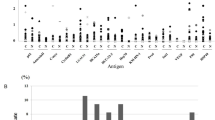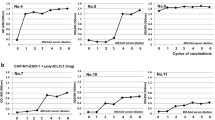Abstract
The aim of this study was to determine the efficacy and the biomarkers of the CHP-NY-ESO-1 vaccine complexed with full-length NY-ESO-1 protein and a cholesteryl pullulan (CHP) in patients with esophageal squamous cell carcinoma (ESCC) after surgery. We conducted a randomized phase II trial. Fifty-four patients with NY-ESO-1–expressing ESCC who underwent radical surgery following cisplatin/5-fluorouracil–based neoadjuvant chemotherapy were assigned to receive either CHP-NY-ESO-1 vaccination or observation as control. Six doses of CHP-NY-ESO-1 were administered subcutaneously once every two weeks, followed by nine more doses once every four weeks. The endpoints were disease-free survival (DFS) and safety. Exploratory analysis of tumor tissues using gene-expression profiles was also performed to seek the biomarker. As there were no serious adverse events in 27 vaccinated patients, we verified the safety of the vaccine. DFS in 2 years were 56.0% and 58.3% in the vaccine arm and in the control, respectively. Twenty-four of 25 patients showed NY-ESO-1-specific IgG responses after vaccination. Analysis of intra-cohort correlations among vaccinated patients revealed that 5% or greater expression of NY-ESO-1 was a favorable factor. Comprehensive analysis of gene expression profiles revealed that the expression of the gene encoding polymeric immunoglobulin receptor (PIGR) in tumors had a significantly favorable impact on outcomes in the vaccinated cohort. The high PIGR-expressing tumors that had higher NY-ESO-1-specific IgA response tended to have favorable prognosis. These results suggest that PIGR would play a major role in tumor immunity in an antigen-specific manner during NY-ESO-1 vaccinations. The IgA response may be relevant.







Similar content being viewed by others
Data availability
To protect patient information in the clinical trial database, the datasets generated and/or analyzed in the present study are not publicly available, but they are available from the corresponding author on request.
Abbreviations
- AUC:
-
Area under the curve
- cGMP:
-
Current good manufacturing practices
- CI:
-
Confidence interval
- CHP:
-
Cholesteryl pullulan
- CT:
-
Computed tomography
- DFS:
-
Disease-free survival
- EC:
-
Esophageal cancer
- ELISA:
-
Enzyme-linked immunosorbent assay
- ESCC:
-
Esophageal squamous cell carcinoma
- γ-GTP:
-
γ-Glutamyl transpeptidase
- IFN-γ :
-
Interferon-γ
- IgA:
-
Immunoglobulin A
- IgM:
-
Immunoglobulin M
- IL-1:
-
Interleukin-1
- IL-4:
-
Interleukin-4
- MAGE-A4:
-
Melanoma-associated gene-A4
- MHC:
-
Major histocompatibility complex
- MRI:
-
Magnetic resonance imaging
- NCI-CTCAE:
-
National Cancer Institute Common Terminology Criteria for Adverse Events
- NKG2D :
-
NK group 2 member D
- NY-ESO-1:
-
New York esophageal squamous cell carcinoma-1
- OD:
-
Optical density
- OS:
-
Overall survival
- PD-1:
-
Programmed-cell death-1
- PIGR :
-
Polymeric immunoglobulin receptor
- PPS:
-
Per-protocol set
- RNA:
-
Ribonucleic acid
- ROC:
-
Receiver operating characteristics
- TNF-α :
-
Tumor necrosis factor-α
- UICC:
-
Union for International Cancer Control
- UMIN:
-
University hospital medical information network
References
Boon T (1993) Tumor antigens recognized by cytolytic T lymphocytes: present perspectives for specific immunotherapy. Int J Cancer 54:177–180. https://doi.org/10.1002/ijc.2910540202
Ferlay J, Colombet M, Soerjomataram I et al (2019) Estimating the global cancer incidence and mortality in 2018: GLOBOCAN sources and methods. Int J Cancer 144:1941–1953. https://doi.org/10.1002/ijc.31937
Shapiro J, van Lanschot JJB, Hulshof MCCM et al (2015) Neoadjuvant chemoradiotherapy plus surgery versus surgery alone for oesophageal or junctional cancer (CROSS): long-term results of a randomised controlled trial. Lancet Oncol 16:1090–1098. https://doi.org/10.1016/S1470-2045(15)00040-6
Ando N, Kato H, Igaki H et al (2012) A randomized trial comparing postoperative adjuvant chemotherapy with cisplatin and 5-fluorouracil versus preoperative chemotherapy for localized advanced squamous cell carcinoma of the thoracic esophagus (JCOG9907). Ann Surg Oncol 19:68–74. https://doi.org/10.1245/s10434-011-2049-9
Mayanagi S, Irino T, Kawakubo H, Kitagawa Y (2019) Neoadjuvant treatment strategy for locally advanced thoracic esophageal cancer. Ann Gastroenterol Surg 3:269–275. https://doi.org/10.1002/ags3.12243
Kelly RJ, Ajani JA, Kuzdzal J et al (2021) Adjuvant nivolumab in resected esophageal or gastroesophageal junction cancer. New Engl J Med 384:1191–1203. https://doi.org/10.1056/NEJMoa2032125
Chen YT, Scanlan MJ, Sahin U et al (1997) A testicular antigen aberrantly expressed in human cancers detected by autologous antibody screening. Proc Natl Acad Sci USA 94:1914–1918. https://doi.org/10.1073/pnas.94.5.1914
Jungbluth AA, Chen YT, Stockert E et al (2001) Immunohistochemical analysis of NY-ESO-1 antigen expression in normal and malignant human tissues. Int J Cancer 92:856–860. https://doi.org/10.1002/ijc.1282
Gu XG, Schmitt M, Hiasa A et al (1998) A novel hydrophobized polysaccharide/oncoprotein complex vaccine induces in vitro and in vivo cellular and humoral immune responses against HER2- expressing murine sarcomas. Cancer Res 58:3385–3390
Muraoka D, Harada N, Hayashi T et al (2014) Nanogel-based immunologically stealth vaccine targets macrophages in the medulla of lymph node and induces potent antitumor immunity. ACS Nano 8:9209–9218. https://doi.org/10.1021/nn502975r
Ikuta Y, Katayama N, Wang L et al (2002) Presentation of a major histocompatibility complex class 1-binding peptide by monocyte-derived dendritic cells incorporating hydrophobized polysaccharide-truncated HER2 protein complex: implications for a polyvalent immuno-cell therapy. Blood 99:3717–3724. https://doi.org/10.1182/blood.V99.10.3717
Kitano S, Kageyama S, Nagata Y et al (2006) HER2-specific T-cell immune responses in patients vaccinated with truncated HER2 protein complexed with nanogels of cholesteryl pullulan. Clin Cancer Res 12:7397–7405. https://doi.org/10.1158/1078-0432.CCR-06-1546
Kageyama S, Wada H, Muro K et al (2013) Dose-dependent effects of NY-ESO-1 protein vaccine complexed with cholesteryl pullulan (CHP-NY-ESO-1) on immune responses and survival benefits of esophageal cancer patients. J Transl Med 11:246. https://doi.org/10.1186/1479-5876-11-246
Murphy R, Green S, Ritter G et al (2005) Recombinant NY-ESO-1 cancer antigen: Production and purification under cGMP conditions. Prep Biochem Biotechnol 35:119–134. https://doi.org/10.1081/PB-200054732
Akiyoshi K, Kobayashi S, Shichibe S et al (1998) Self-assembled hydrogel nanoparticle of cholesterol-bearing pullulan as a carrier of protein drugs: complexation and stabilization of insulin. J Control Release 54:313–320. https://doi.org/10.1016/S0168-3659(98)00017-0
Stockert E, Jäger E, Chen Y-T et al (1998) A survey of the humoral immune response of cancer patients to a panel of human tumor antigens. J Exp Med 187:1349–1354. https://doi.org/10.1084/jem.187.8.1349
Kaetzel CS (2005) The polymeric immunoglobulin receptor: Bridging innate and adaptive immune responses at mucosal surfaces. Immunol Rev 206:83–99. https://doi.org/10.1111/j.0105-2896.2005.00278.x
Figueiredo DLA, Mamede RCM, Spagnoli GC et al (2011) High expression of cancer testis antigens MAGE-A, MAGE-C1/CT7, MAGE-C2/CT10, NY-ESO-1, and gage in advanced squamous cell carcinoma of the larynx. Head Neck 33:702–707. https://doi.org/10.1002/hed.21522
Szender JB, Papanicolau-Sengos A, Eng KH et al (2017) NY-ESO-1 expression predicts an aggressive phenotype of ovarian cancer. Gynecol Oncol 145:420–425. https://doi.org/10.1016/j.ygyno.2017.03.509
Ueda S, Miyahara Y, Nagata Y, Sato E, Shiraishi T, Harada N, Ikeda H, Shiku H, Kageyama S (2018) NY-ESO-1 antigen expression and immune response are associated with poor prognosis in MAGE-A4-vaccinated patients with esophageal or head/neck squamous cell carcinoma. Oncotarget 9(89):35997–36011. https://doi.org/10.18632/oncotarget.26323
Hayashi M, Takenouchi N, Asano M et al (1997) The polymeric immunoglobulin receptor (secretory component) in a human intestinal epithelial cell line is up-regulated by interleukin-1. Immunology 92:220–225. https://doi.org/10.1046/j.1365-2567.1997.00341.x
Piskurich JF, France JA, Tamer CM et al (1993) Interferon-γ induces polymeric immunoglobulin receptor mrna in human intestinal epithelial cells by a protein synthesis dependent mechanism. Mol Immunol 30:413–421. https://doi.org/10.1016/0161-5890(93)90071-I
Moon C, VanDussen KL, Miyoshi H, Stappenbeck TS (2014) Development of a primary mouse intestinal epithelial cell monolayer culture system to evaluate factors that modulate IgA transcytosis. Mucosal Immunol 7:818–828. https://doi.org/10.1038/mi.2013.98
Kumar P, Monin L, Castillo P et al (2016) Intestinal Interleukin-17 receptor signaling mediates reciprocal control of the gut microbiota and autoimmune inflammation. Immunity 44:659–671. https://doi.org/10.1016/j.immuni.2016.02.007
Fristedt R, Gaber A, Hedner C et al (2014) Expression and prognostic significance of the polymeric immunoglobulin receptor in esophageal and gastric adenocarcinoma. J Transl Med 12:83. https://doi.org/10.1186/1479-5876-12-83
Fristedt R, Elebro J, Gaber A et al (2014) Reduced expression of the polymeric immunoglobulin receptor in pancreatic and periampullary adenocarcinoma signifies tumour progression and poor prognosis. PLoS ONE 9:e112728. https://doi.org/10.1371/journal.pone.0112728
Biswas S, Mandal G, Payne KK et al (2021) IgA transcytosis and antigen recognition govern ovarian cancer immunity. Nature 591:464–470. https://doi.org/10.1038/s41586-020-03144-0
Acknowledgements
We are grateful to all the patients who took part in this study, their caregivers, and the co-medical staff, data managers, and clinical coordinators. Ms.Sahoko Sugino and Ms. Junko Nakamura (Mie University) provided technical assistance with the ELISA assay. We thank all co-workers from FIVERINGS CO., LTD. for operating this study.
Funding
The trial was supported by research funding from the Ministry of Health, Labour and Welfare, Japan between April 2011 and March 2015, and then supported by Japan Agency for Medical Research and Development (AMED) between April 2015 and March 2018 (Grant Number JP17ck0106143).
Author information
Authors and Affiliations
Contributions
YN, SK, TY, and HS contributed to the design of the study. YN, TI, SK, TO, TA, MM, KO, TA, TK, KT, SK, HS, SY, TS, SH, TT, TS, SU, KK, AY, HW, YD, HY, MK, MO, HY, KK, MK, YK, and MK contributed to patient recruitment, treatment, and clinical data collection. YM, NG, EF, and KY contributed to immune reaction data. TS and ES contributed to immunohistochemical staining of tumor tissues. YN, SK, HI, TY, MO, KH, HM, and TW interpreted the data. TY and MO performed the statistical analyses. YN and SK wrote the manuscript. All authors contributed to draft revisions and approved the final manuscript.
Corresponding authors
Ethics declarations
Conflict of interest
All authors declare that they have no conflicts of interest.
Ethical approval
All procedures performed in our studies involving human participants were conducted in accordance with Japanese Ethical Guidelines for Clinical Research, Japanese Guidelines for Medical and Health Research Involving Human Subjects, and the Helsinki Declaration. The Institutional Review Board reviewed and approved the protocol and the informed consent documents and their amendments before use (Mie University approval number F2408005).
Informed consent
Written informed consent to participate in the study and for the use of clinical data for research and publication was obtained from all patients included in the studies: Mie University approval number F2408005.
Additional information
Publisher's Note
Springer Nature remains neutral with regard to jurisdictional claims in published maps and institutional affiliations.
Rights and permissions
About this article
Cite this article
Nagata, Y., Kageyama, S., Ishikawa, T. et al. Prognostic significance of NY-ESO-1 antigen and PIGR expression in esophageal tumors of CHP-NY-ESO-1-vaccinated patients as adjuvant therapy. Cancer Immunol Immunother 71, 2743–2755 (2022). https://doi.org/10.1007/s00262-022-03194-5
Received:
Accepted:
Published:
Issue Date:
DOI: https://doi.org/10.1007/s00262-022-03194-5




